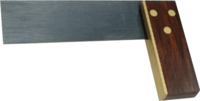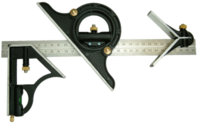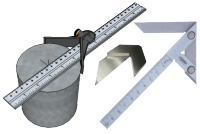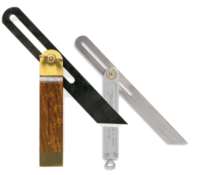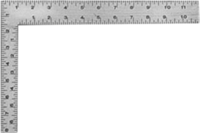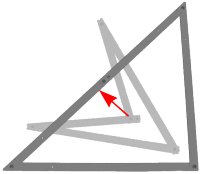Squares: Difference between revisions
From DT Online
mNo edit summary |
mNo edit summary |
||
| Line 13: | Line 13: | ||
| '''Double Square''' | | '''Double Square''' | ||
| This adjustable square can be used not only as a Try Square, especially wheh needing to square lines in a [https://en.wikipedia.org/wiki/Rabbet '''Rebate'''] for example, but also as a Depth Gauge and as a gauge when marking lines parallel to an edge. | | This adjustable square can be used not only as a Try Square, especially wheh needing to square lines in a [https://en.wikipedia.org/wiki/Rabbet '''Rebate'''] for example, but also as a Depth Gauge and as a gauge when marking lines parallel to an edge. | ||
| [[File:DoubleSquare.PNG| | | [[File:DoubleSquare.PNG|150px|right]] | ||
|- | |- | ||
| [https://en.wikipedia.org/wiki/Combination_square '''Combination Square'''] | | [https://en.wikipedia.org/wiki/Combination_square '''Combination Square'''] | ||
Revision as of 07:43, 22 July 2015
Squares of various types are used mainly to test the Squareness of a piece of material or a construction and also to mark lines, usually at right-angles, from an edge or surface
| Carpenter's Try Square | Used for general woodworking when needing to test for Squareness or to mark lines at right-angles to a surface or edge - usually with a Marking Knife or Pencil. | |
| Engineer's Try Square | For general metalworking, an all steel version is used. They resist wear well and are precision made to ensure accuracy. The notch on the inside of the stock is there to ensure the stock butts right up to the edge of the material without interference by small particles or burrs . | |
| Double Square | This adjustable square can be used not only as a Try Square, especially wheh needing to square lines in a Rebate for example, but also as a Depth Gauge and as a gauge when marking lines parallel to an edge. | |
| Combination Square | These have an adjustable Double Square stock with one face at 90 degrees and another at 45 degrees for drawing mitres. They comprise also a Protractor to mark lines at any angle and Centre Square to find the centre of a bar or disc. | |
| Centre Square (or Centre Finder) | When pressed against the Circumference of a circular disc or bar, the stock forms two Tangents. The blade is the Bisector of them and always passes through the circle centre. Marking two or more lines therefore will define the circle centre where they intersect. Centre Squares are a feature of a Combination Square and also available as separate tools. | |
| Mitre Square | These are constructed in much the same way as a Try Square but the blade is set at 45 degrees to the stock. | |
| Bevel Square (aka Bevel Gauge or Sliding Bevel) | These adjust to enable lines to be marked at any angle and bevels or chamfers to be checked. | |
| Framing Square | A large ‘L’-shaped tool used to check the Squareness of frame constructions for example.
Note: Large rectangular frames can also be checked for Squareness by testing that its Diagonals are equal in length. |
|
| Builder's Square | These large folding squares (e.g. typically 1200mm) are based on a special case triangle of sides in the proportion 3,4, and 5 which by the Pythagoras Theorem will always create a right-angled triangle. | |
| T-square | A drawing instrument comprising usually a plastics blade and stock made also of plastics or wood which is pressed against the edge of a drawing board to enable parallel lines to be drawn across. | |
| Set Squares | Triangular shaped drawing instruments usually used in conjunction with a T-square or rule to draw lines at 45, 60, 30 and 90 degrees to it. |
